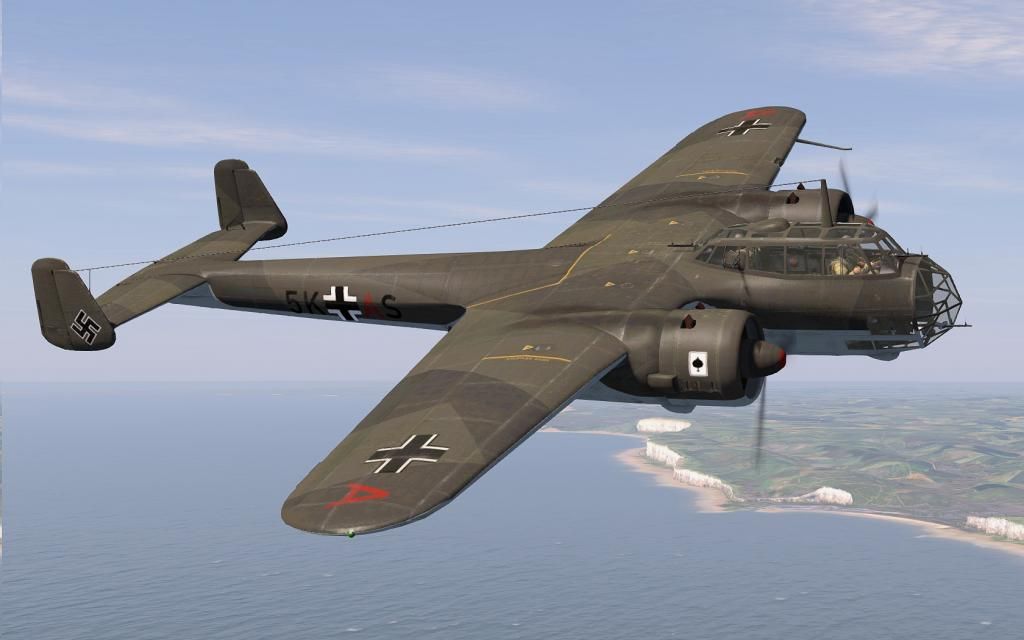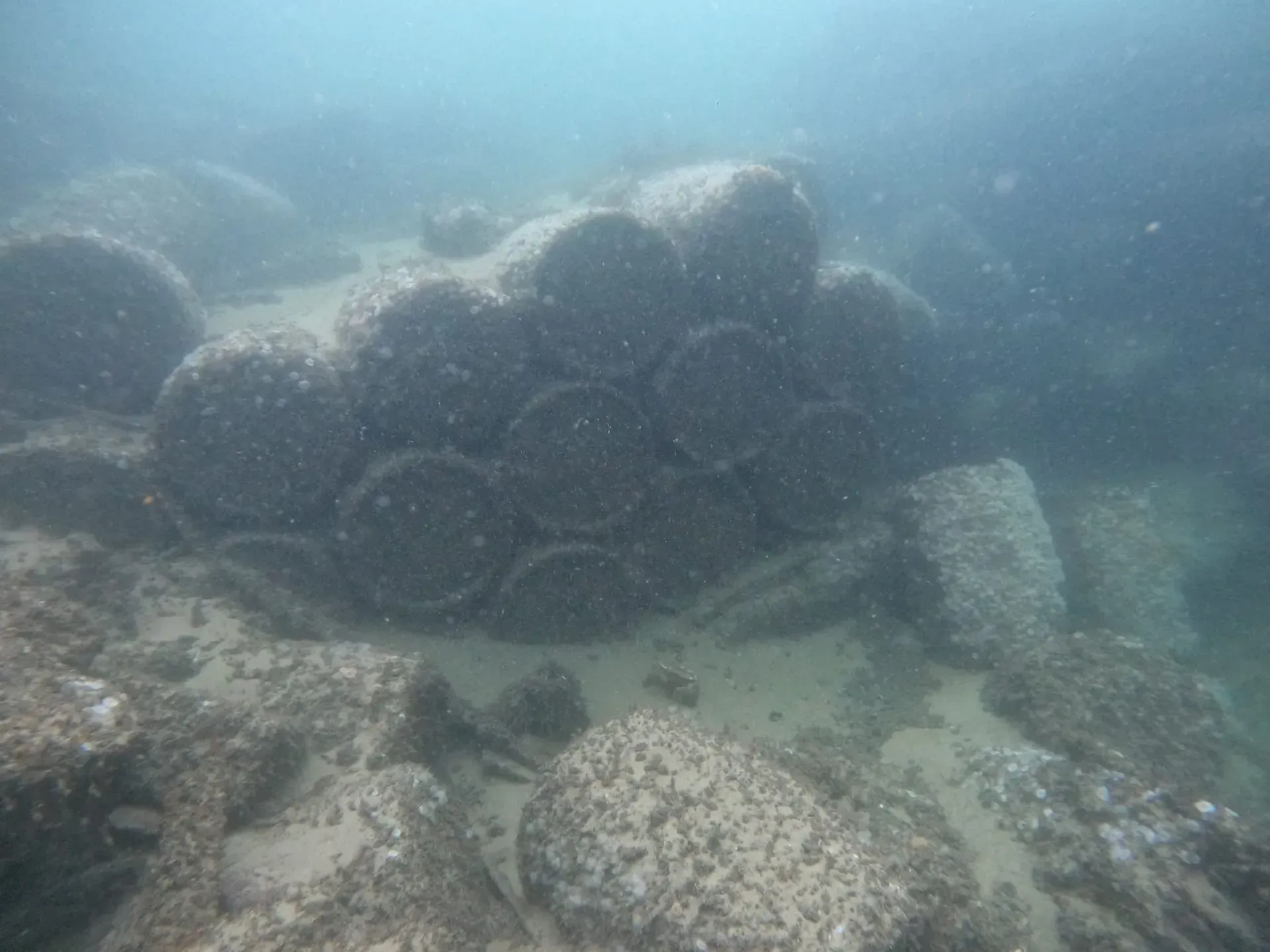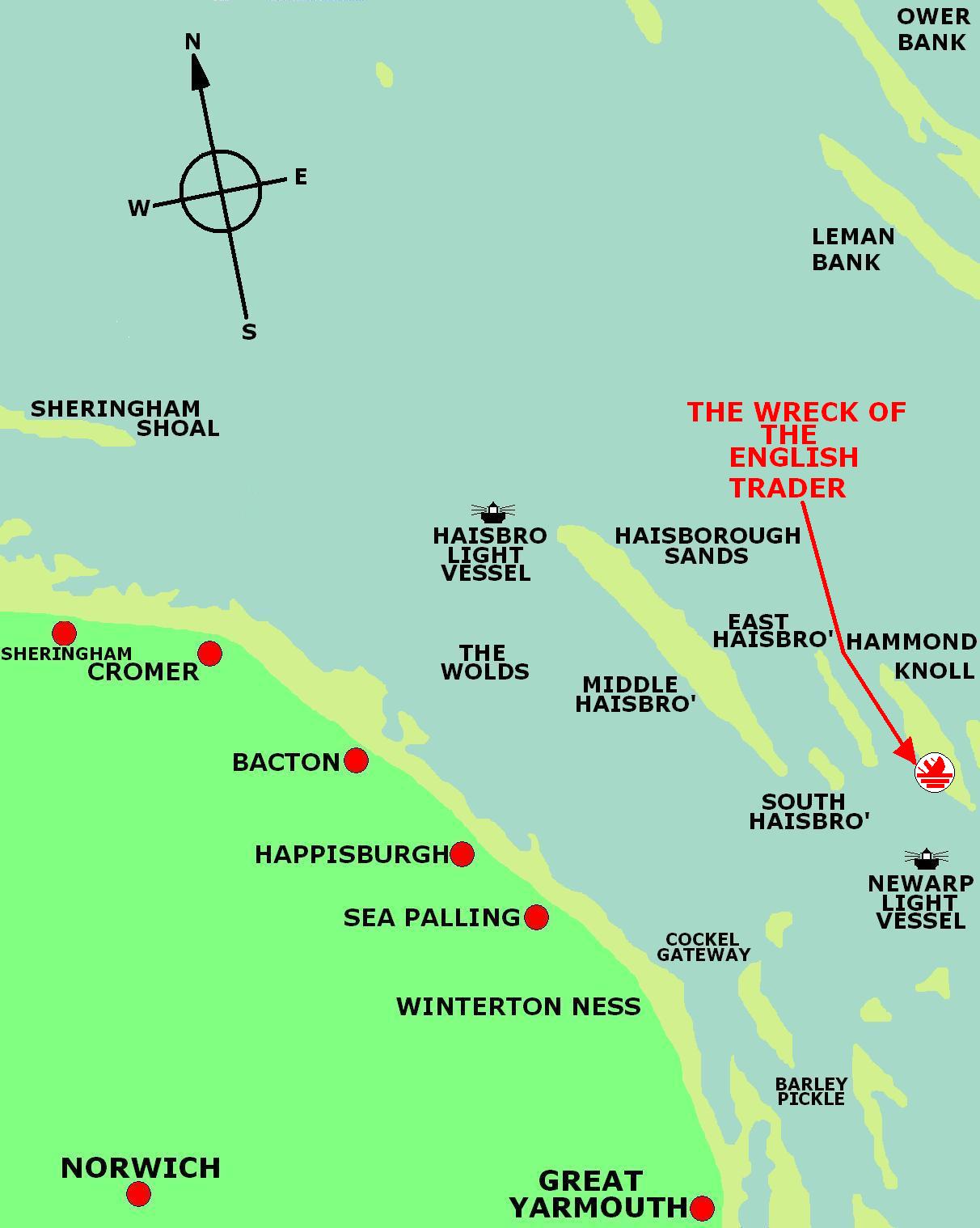History ... Built in 1934 as the Arctees by the Furness Shipbuilding Company Ltd. Designed by Joseph Isherwood, the English Trader's design incorporated Isherwood's revolutionary Arcform hull design, this in turn improved fuel consumption. In 1936 the Arctees was sold to the Trader Navigation Company Ltd and renamed the English Trader. In 1937 the English Trader grounded on the rocks near Dartmouth Castle in Devon, this in turn resulting in her bow section having to be cut off whilst on the rocks and the remainder of the vessel being salvaged. The contract for the repairs to the English Trader was given to the Middle Docks Engineering Company of South Shields. The works undertaken took 100 days and involved replacing her entire bow section and also included various other repair work to her damaged hull from the boiler room forward.
Above ... The English Trader under her former name of Arctees
ENGLISH TRADER
Position ... 52 52 975 N / 001 54 187 E
Type ... Cargo, cruiser stern, steel, poop 33ft, bridge 226ft, forecastle 31ft, x4 holds with locked steel interchangeable hatches
Built ... 1934
Builder ... Furness Shipbuilding Co Ltd, Middlesbrough
Yard no ... 226
Official no ... 163446
Engine builder ... North Eastern Marine Engineers Ltd, Sunderland
Tonnage ... 3953 grt / 2382 Net / 3666 Underdeck
Dimensions ... 110.34 x 17.37 x 7.01 mtrs
Engine ... x1 three cylinder triple expansion engine // 21.5, 37, 62 x 42 inch stroke
Boilers ... Main boilers x2 single ended x3 corrugated furnaces per boiler, x1 single ended auxiliary boiler x2 corrugated furnaces. Furnace builder Deighton's Patent Flue & Tube Company
Double bottom ... Yes
Power ... 357 nhp
Speed ... 9 knots
Lost ... 26 / 10/ 1941
Cause ... Ran aground ( en route, London to Mombasa)
Cargo ... General 7000 tons
Lives lost (4 English Trader crew) ... / Albert Michael Berry, Fireman and Trimmer / Ronald James Biss, Able Seaman / Henry Pugh, Fireman and Trimmer / Richard Thomas, Chief Engineer Officer
Lives lost (1 RNLI crew member) Edward W. Allen
Armed ... x1 four inch semi automatic quick fire / x1 twelve pounder / x2 Oerlikon guns
Below ... Tower Hill memorial, London. The four lost crew members of the English Trader. Courtesy of Andrew Watson.

Below ... The English Trader's bell (Henry Blogg Museum Cromer)
Below ... Layout of the Engish Trader

Weapon systems onboard the English Trader
WW2 was to see the English Trader carry thousands of tons of cargo to and from the British Isles. On October 24th 1941 and loaded with a general cargo the English Trader headed out of the Thames en route for Mombasa in Kenya. Amongst her cargo were tractors, and other agricultural goods, pocket watches, umbrellas, whisky, Andrews Liver Salts, clothing, kitchenware, Ponds Cold Cream, paraffin table lamps, paraffin tilley lamps, copper wire, various medical supplies, Bovril, insulators, tea pots, wine, beer, belts for the Ugandan police force, bottles of ink (Quink), copper household taps, glass baby feeding bottles, copper door handles, bronze ingots and white bronze ingots. In addition there are large amounts of solidified barrel contents amongst the wreck, the wood now having long rotted away (contents unknown). Stamped on many of the cases was "BRITAIN DELIVERS THE GOODS", this being in defiance of Germany.
Convoy EC 90
On leaving the Thames and joining convoy EC90, the English Trader had taken on many new crew members, in fact out of her crew of 47 only 8 were pre serving crew members on the Trader, this eight included Captain Grimstone and his three deck officers, the mate John Elliot, William Hickson the gun layer, two other gunners and the ship steward. By late afternoon of the 24th the Trader had reached Southend On Sea and joined convoy EC90. The convoy consisted 20 ocean-going freighters, two or three coastal steamers and two Royal Navy destroyers, one of which was the ageing HMS Vesper. The convoy, with a steady speed of 8-9 knots or so proceeded to head up the east coast of England. For the Trader this was her maximum speed, this in turn thought to be down to her new inexperienced crew who did not know how to get the best speed out of her. By late afternoon of the 24th, due to her lack of speed, the Trader found herself about half a mile behind the main convoy. On seeing that the Trader was lagging behind the rest of the convoy, Captain Grimstone was instructed to make for one of the east coast ports if his ship could not keep up.
Aircraft attack
By nightfall the Trader was now five miles behind the rest of the convoy and at times could hold no more than 4 knots, this in turn making her any easy target for an enemy attack. Later in the night, the forward convoy came under an air attack, this then followed an attack on the Trader by a Dornier DO-17 bomber. The attacking aircraft released two bombs during its attack, both of which missed. HMS Vesper, which had broken off from the main convoy in order to help opened fire on the aircraft, this possibly damaging it as it broke off its attack and was not seen again.
Below ... Dornier DO17
Aground on Hammond Knoll
By 1.30am on October 26th and struggling against the tide, the Trader found herself dangerously close to the Hammond Knoll. At 1.45am all was lost as the Trader grounded on the knoll. With daybreak the weather conditions started to deteriorate and wind speeds increased to gale force. The Trader was not to last long, with waves crashing against her hull and swamping her decks her back eventually broke and she proceeded to break up. Reports at the time state that much of her cargo was washed out of her and drifted away on the tide.
Below ... Solidified contents of casks, cargo, contents unknown. The wooden casks having long rotted away. Courtesy of Stan Moore. (Anglian Divers)
Below ... Location of the English Trader on Hammond Knoll
Below ... Scan image of the English Trader. Courtesy of Neil Hooper

Below ... Stockless bow anchor. Above the anchor arms the plating has rotted away and now reveals the hawsepipe that the anchor shank is drawn in to when the anchor is raised. Courtesy of Stan Moore (Anglian Divers)

Below ... Winch. Courtesy of Stan Moore (Anglian Divers)

Below ... Porcelain cable insulator (cargo)
Below ... Funnels (cargo) Held at the Henry Blogg museum, Cromer

Below ... Bronze ingots (cargo) Henry Blogg museum (Cromer)

Below ... Ponds Cold Cream jars (cargo) Courtesy of Roger Smith (Anglian Divers)
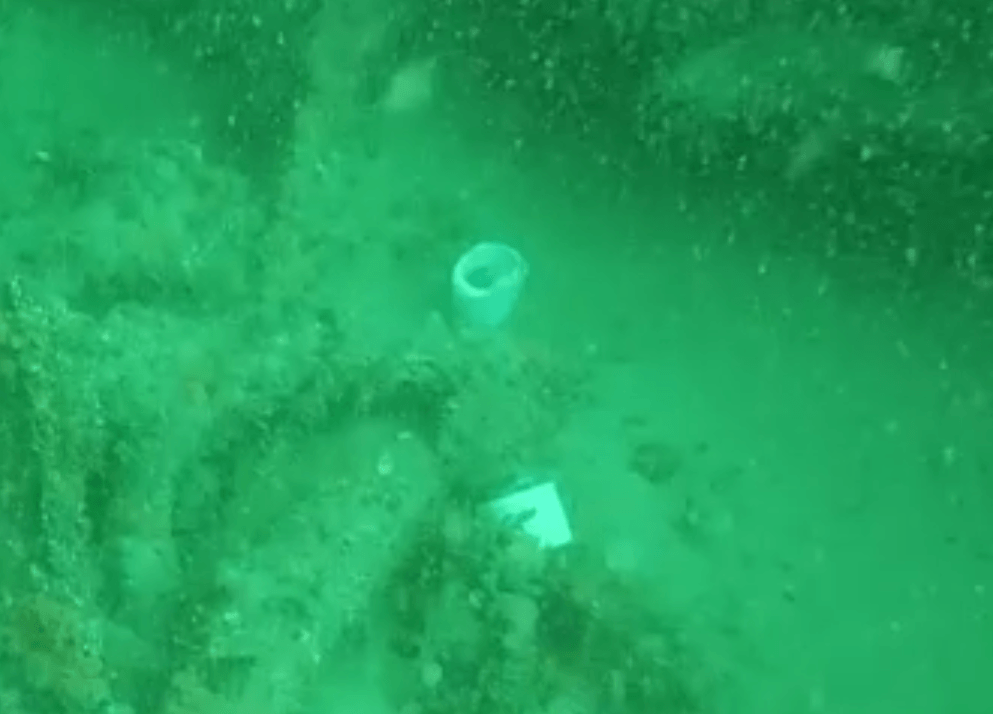
Lifeboat launched
At 8.15 am, the Cromer lifeboat station was alerted as to the Traders stranding and launched the lifeboat H F Bailey, coxswained by Henry Blogg. She was crewed by twelve men including the triple RNLI Gold Medal holding coxswain Henry Blogg. By 11.35 the H F Bailey reached Hammond Knoll. By the time Henry Blogg and his crew reached the stricken Trader, 3 of the Trader's crew had already perished having been swept over board. The remainder of the crew had now taken refuge in the ships chart room awaiting rescue, this being the highest point of the ship and in turn the most safe in the ongoing gale force conditions. The H F Bailey made two attempts to get a line to the English Trader without any success. A third attempt was made at a rescue but resulted in near disaster for the H F Bailey and in the death of one of her crew (Edward W Allen). At 3 pm and after 7 hours of various rescue attempts, Henry Blogg and his crew broke off the rescue attempt and headed for Yarmouth. In the meantime, the Great Yarmouth Lifeboat had been launched and was on its way. Over a 2 hour period the Yarmouth lifeboat made 5 unsuccessful attempts at securing the rescue of any of the Traders crew and reluctantly also returned to Yarmouth after receiving orders to do so from the Royal Navy. By 8 am the next morning and with the sea having calmed considerably, Blogg and his crew were back on the knoll and managed to rescue the 44 remaining crew from the Trader and from there took them to Yarmouth. Reports from the following day state that the English Trader had gone completely under the waves. Henry Blogg received a RNLI Silver Medal for this rescue
Below ... The Watson Class lifeboat H.F. Bailey. Built by J. S. White of Cowes, Isle of White at a cost of £7,569. She was 45 feet in length, single screwed with her engine delivering 80hp.
.
Below ... Diver alongside the triple expansion engine. Courtesy of Stan Moore (Anglian Divers)
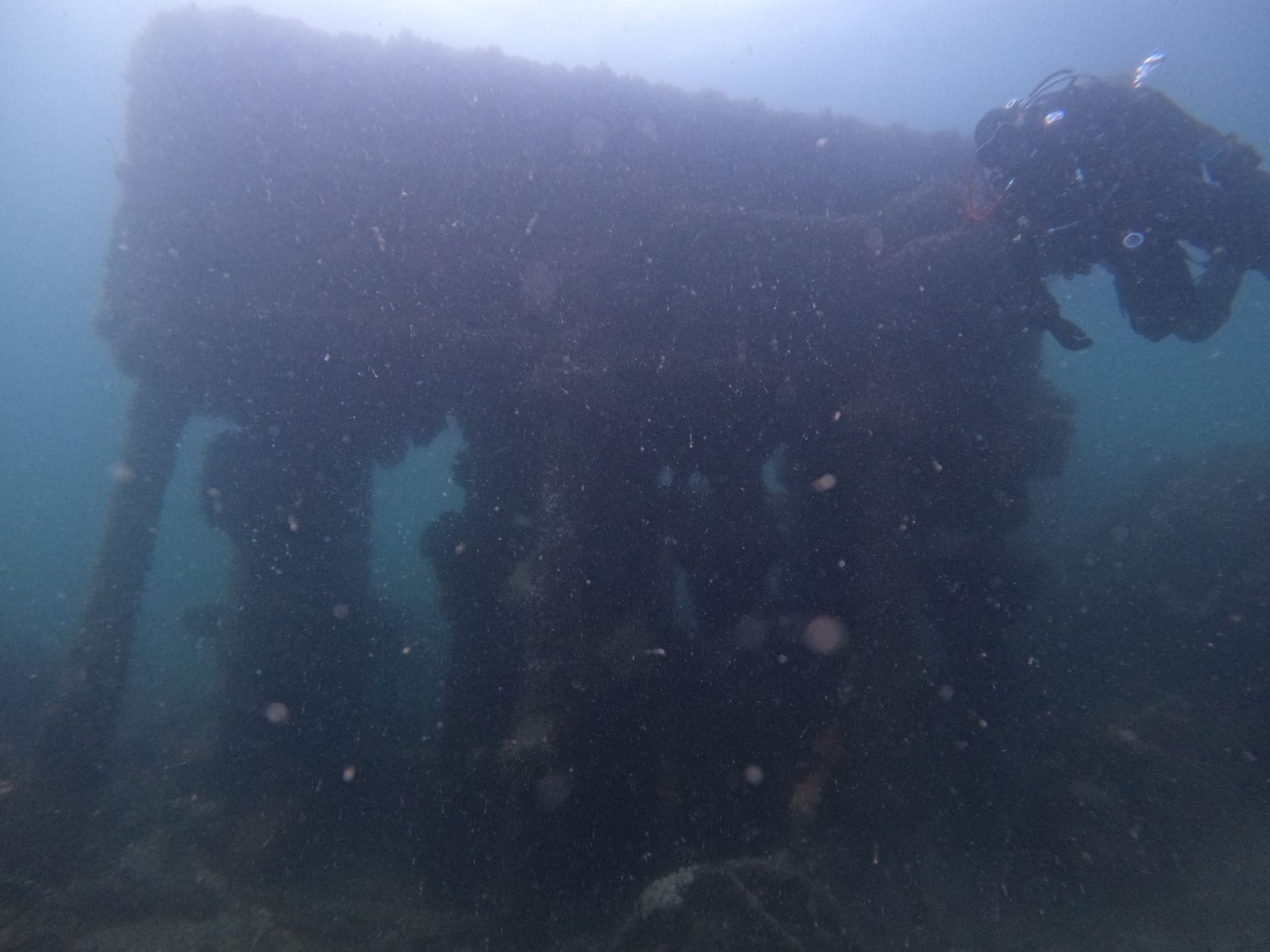
Below, Double bottom cross section as incorporated in the English Trader .... A double bottom is a method of construction where the bottom of the ship has two separate layers of watertight hull floor. The outer layer forms the outer hull and the inner layer, ie the floor forms a watertight barrier should the outer hull be breached. Up until 2007, double bottomed vessels were allowed to utilise their DB's for fuel storage. In addition the DB can also be used for the storage of ballast water.

UKHO
1942 ... Only gun and platform show above LW
1951 ... Least depth over wreck 4 feet
1992 ... Strong magnetic deflection / wreck not found in vicinity of charted position. Consider wreck to be buried.
The English Trader Today (2022) ... Due to a max depth of 10-12mtrs the ET makes for an excellent dive with plenty of bottom time to explore all that this magnificent wreck has to offer. At the time of writing (2022), large areas of the wreck have now become exposed as the sand has now receded in and around many areas of the site. The ET makes for an excellent rummage dive, with evidence of her 7000 tons of general cargo to be found in every nook and cranny. The engine and boilers are in situe and upright with the boilers sanded in to the top of the furnaces. In and around the engine area can be found various pieces of pipework and fittings associated with the engine and boiler room along with large pieces of bunker coal.











